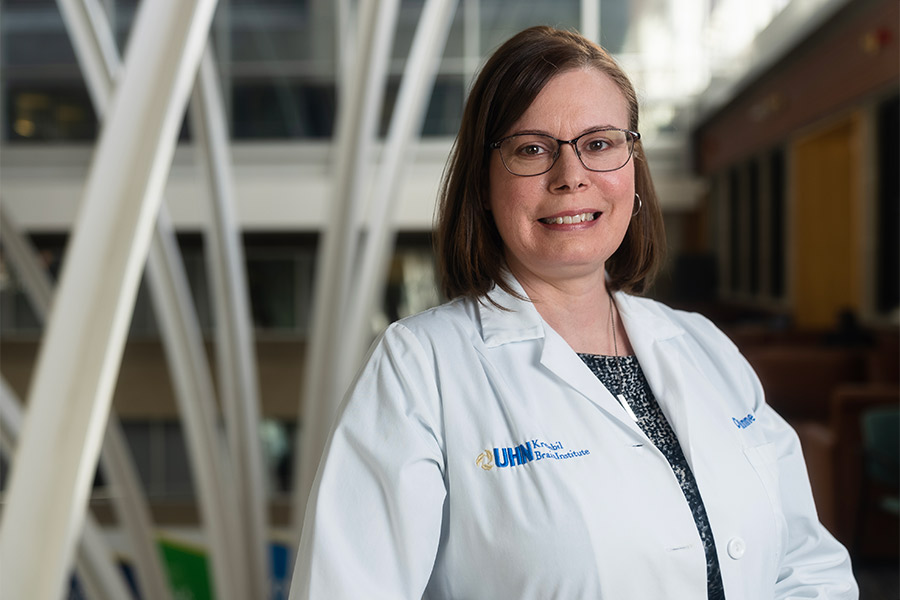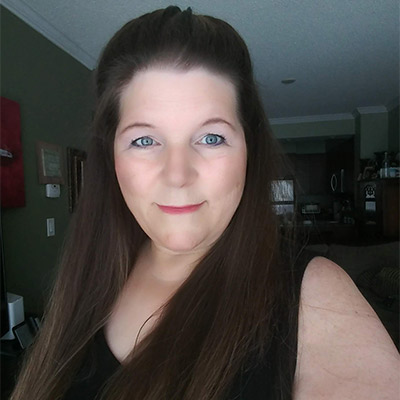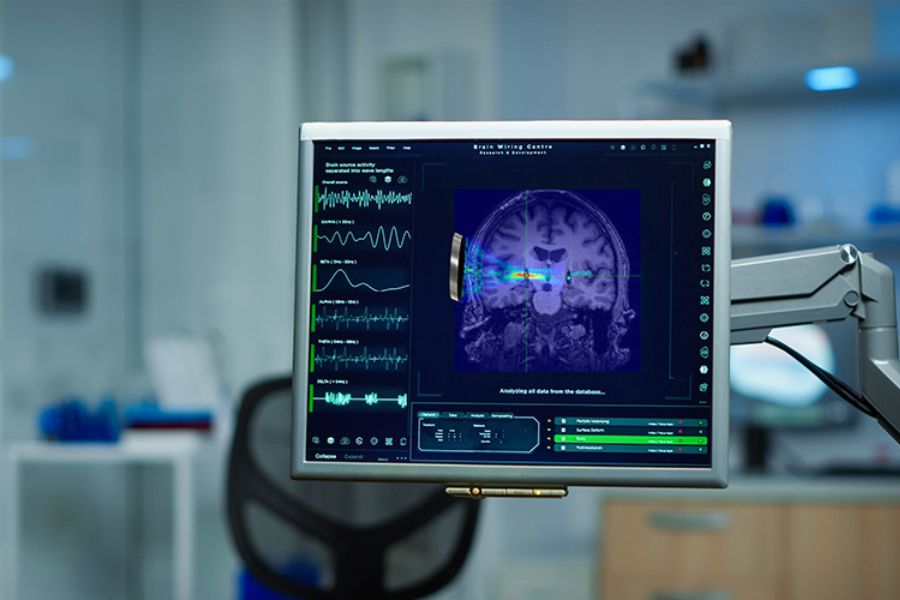Anne Cayley has seen stroke care evolve in her 36 years as a nurse practitioner. “It’s really exciting to be a part of it.” (Photo: UHN)
In the 10 years since the Neurovascular Unit (NVU) at Toronto Western Hospital, part of the Krembil Brain Institute at UHN, was officially opened, the team has seen major advancements in stroke care.
That has resulted in increased positive outcomes for patients and the achievement of Stroke Distinction twice in a row; first, four years ago, and again last month from Accreditation Canada, for overall excellence in acute stroke services.
In their own words, two key members of this dedicated team, and one patient, reflect on the past decade.
Dr. Leanne Casaubon – neurologist, clinician investigator and Medical Director of the Stroke Program at UHN’s Krembil Brain Institute:
The Neurovascular Unit was officially opened on Nov. 30, 2011, with a goal of better coordinating care for our stroke patients. Prior to the unit existing, we had patients in different departments, on different floors within the hospital, being cared for by different teams.
Dr. Frank Silver from the stroke team, Dr. Michael Tymianski on the neurosurgical team, and myself came together with General Internal Medicine, where many of our patients were then receiving care, and we created this idea of a specialized unit, focused on using the best practices in stroke care.

We knew that patients would have more optimal outcomes if they were cared for by people with expertise in stroke and neurovascular care, and if there was a synergistic approach between stroke neurologists, vascular neurosurgeons, interventional neuroradiologists, and skilled nurses, advanced practices nurses, allied health staff including physiotherapists, occupational therapists, speech-language pathologists, and social workers, pharmacists, and other support staff.
When it actually came together, it was an amazing feat that provided the best opportunity for excellence in care for persons with stroke and other neurovascular conditions.
Anne Cayley – nurse practitioner in the Stroke Program
It was a fabulous moment because we had been working for two years behind the scenes to prepare. There were a lot of meetings with various stakeholders, a lot of preparation, and a lot of training to develop the staff, and just to see it all come to fruition was pretty incredible. The fact that it was so unique was captivating and a lot of people were interested in working with us.
I have been a nurse for 36 years. My earliest memories of stroke patients were that they were patients that had little hope, who would most likely end up in nursing homes.
But with new research and advancements in clinical care, I started to realize there was a lot more that could be done for stroke patients, in terms of their medical management. It started with education – if the patients understood the signs of stroke and what to do, they would come in for care sooner. If they came in sooner, we could potentially rehab them faster. If we had better protocols and systems in place and if patients better understood to call 911 earlier, outcomes were better.
The Neurovascular Unit was an inpatient unit. Dr. Casaubon and Anne Cayley both saw a need to be able to treat more patients coming in with milder forms of stroke, using different and expanded levels of care. An idea was born.
Watch the Krembil Minute video on Stroke.
Leanne Casaubon:
Anne and I knew that we also needed to improve our best practices for patients with milder forms of stroke, such as a transient ischemic attack (TIA), also known as a “mini” stroke, which only lasts minutes to hours and often doesn’t cause permanent damage, but can be a warning sign of more major strokes to come. So we created the TAMS Unit (TIA And Minor Stroke), giving patients rapid access to immediate stroke care in a day-unit structure. We essentially replicated an inpatient stay in an outpatient world.
It wasn’t a fully funded project at the start but thankfully, three years ago, we did get the project funded. We were working as a five-day, weekday model and the hospital was supporting it. We quickly realized that TAMS needed to be a seven-day, full-time unit to be able to help the sheer volume of patients with non-disabling stroke. It soon became a fully funded seven-day TAMS unit, and today, it’s the only program of its kind in the province, which feels fantastic. It’s really special to be able to provide this level of care and see such promising results.
When we look back and reflect on our whole journey, beginning with the inception of the Neurovascular Unit and the TAMS Unit, it’s just amazing. With the Neurovascular Unit, we brought together experts in the fields of stroke and neurovascular care to enhance patient care but also to advance neurovascular research and education. Then, TAMS provided innovation and personalized care for a large population of people at risk of major, disabling stroke to help prevent such events.
A lot of it was daunting, to actually get these projects off the ground, but when you have a great group of people who are passionate about what they do, this is the result.
Anne Cayley:
Helping people is why we get into nursing. It makes us feel good to be able to give back and the nursing team in the stroke unit are the best of the bunch. We feel privileged to work here, to learn about stroke and to be able to help patients and their families.
We had a patient recently who had stopped taking his medications because he couldn’t manage it financially. He also needed help with managing his blood pressure, his sugar levels, and he needed orthopedic care. So we helped him with a care plan, including choices for medications that he could afford and we helped him make the appointments he needed to stay on track with his post-stroke recovery.
We’ve been able to treat patients earlier, identify problems earlier, recognize patients with other medical issues and be able to treat them medically. We’ve also been able to take the burden off the Emergency Department, offset that and prevent hospital admissions by seeing patients quickly and sooner, to optimize their outcome.
I was an emergency room nurse for 20 years before coming to the stroke unit. I just love to make sure people have the best care and I have an interest in going the extra mile. I think people deserve when they’re sick, to be cared for and to get the information they need, so I to try to be as helpful as I can.
A stroke can be devastating. You may not be able to talk, eat or touch your loved one, it robs you of so much. But we see in our patient’s faces how thankful they are to have this level of care. We are there for them and help guide them not only through the stroke, but we also help with resources, appointments, education, and that is so appreciated by patients and their families.
In March of 2014, 48-year-old Stacey Yepes experienced a stroke. As she sat in her car, one side of her face drooping, Stacey videotaped herself. She went to the ED of a Toronto hospital. Once they saw the video, they quickly referred Stacey to the TAMS Unit at Toronto Western, where she was triaged by nurse practitioner Anne Cayley.

Stacey Yepes:
I remember Anne vividly, her calmness in the situation as I panicked, her professionalism explaining the situation and the process of what was going to happen, so I wasn’t overwhelmed by it. She always returned my call if I had a question. It just means the world when you’re going through something like this. None of my family live in Toronto, so they were especially thankful that I had this level of care.
I had four months of intensive rehab following my stroke and I still go for yearly follow ups, but I’m back to work and living my life as fully and as gratefully as I can. I truly can’t imagine where my life would be or if I would even be here, if it wasn’t for Toronto Western and the TAMS Unit.
Leanne Casaubon:
Our team-based approach is what sets us apart and what helps us achieve our high standards. We’ve really built a program where we’ve been able to enhance our services, and that’s because of our people and their dedication.
And what we have created in the last decade is a world-class program that consistently demonstrates excellence in positive patient outcomes. We have one of the lowest in-hospital mortality rates across the province. We have one of the highest rates of referrals to stroke prevention services, and we know those specialized services improve outcomes and reduce mortality.
We have immediate access to resources patients need for their evaluation and treatments. Growing together as a team, this interdisciplinary approach has given us a level of expertise that allows us to increase patient volumes through efficiencies in care and address even more complex cases. Others are emulating us now. It’s the best compliment.
I never tire of hearing patients thank our team members. They appreciate the time that’s taken to guide them through the care process, and the information and education that we provide for them to understand what they’re going through. The TAMS Unit is one example, but our interdisciplinary team’s approach to stroke endovascular thrombectomy (EVT) is another. There, you’ve got a high-risk situation of a sudden, disabling stroke, high acuity, with time sensitive treatments, and families always acknowledge the coordinated and extremely prompt and comprehensive care they receive.
Watch Dr. Timo Krings on why he loves helping stroke patients.
Anne Cayley:
What I love most about nursing is the people. I love hearing their stories, trying to understand from their point of view what they feel they need, or what their main issues are, and then helping them to create a care plan. We only see them for a short time, so we always want to make sure they are cared for afterwards in the community, that they have the right resources. We’re just a drop in the bucket, one point of care in these patients’ journeys. It makes you feel good to know you’ve helped them out and made their journey easier.
When I started my career, if I had a stroke patient in my unit, the situation felt hopeless. Now, it’s hopeful. We are doing routine endovascular thrombectomy procedures to remove clots and giving a stroke drug called tPA to eligible patients and we’ve seen a dramatic increase in improved outcomes with patients either going home or to rehab after their stroke.
All of the advancements of the past decade, coupled with centralizing stroke care in one unit, has really had a positive impact for our patients. That’s what we wanted. We are so dedicated, we’ve gone through two rigorous Stroke Distinction processes, looking at our excellence in standards, indicators and benchmarks, to keep on top of providing the best care. I think it demonstrates our commitment to not only meeting but exceeding our standards when it comes to stroke care.
We’re a model unit and program and we want to build upon that. We want to be able to now go outside of UHN and have more of an integrated best practice model with our community partners as well.
I feel proud and privileged to work in this program. I want all patients to come here to Toronto Western, to be able to access the high-quality stroke care that we provide.


